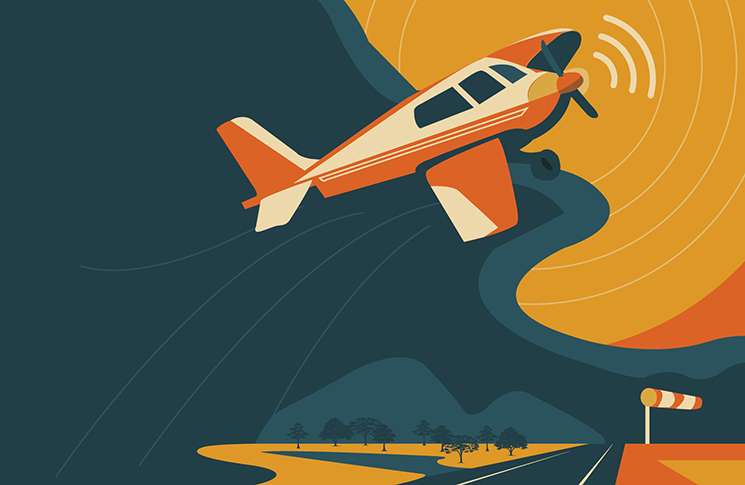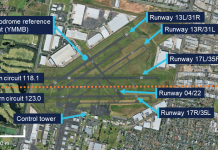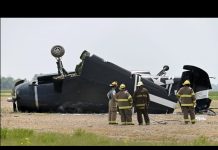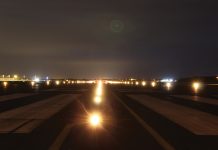Flying into a non-controlled (CTAF) aerodrome can feel like a lively conversation where everyone’s talking, but no-one is listening. Unlike controlled airspace, uncontrolled airfields require a sharp mind, solid planning and clear communication to keep things running smoothly. So, how do you make sure you’re setting yourself up for success before you get airborne?
Let’s dive into 5 essential steps you can adopt to master your CTAF operations.
1. Prep like you’re on a secret mission
Most pilots are familiar with the standard pre-flight ritual: check ERSA, plot your route on OzRunways or AvPlan and review your maps. But in my experience, mastering the CTAF goes beyond the basics.
- Gather intel on your airfield: many airfields maintain websites with up-to-date details on conditions, procedures and temporary restrictions. It’s worth visiting before you arrive and then perhaps realise new procedures or protocols are not yet reflected in ERSA.
- Google Maps, your secret weapon: a satellite view of the airport and its surroundings can help you visualise the layout before arrival. Spot obstacles, identify alternate landing areas and get a feel for the terrain. You can also review taxiways and parking areas after landing.
- Know your airspace buddies: some uncontrolled airports have a mix of air transport services, medical helicopters and general aviation aircraft. Know who you’re sharing the air with and anticipate how their procedures might differ from yours. You don’t want to mess up circuit joins or radio calls when larger aircraft join the circuit.
Storytime:
I remember when I was training for my PPL and practising for my first solo navex with my instructor. The route took us from Bankstown to Oberon to Goulburn, up through Bundanoon and The Oaks and back to Bankstown.
During our pre-flight planning, the instructor printed out a satellite snap of Oberon Correctional Centre from Google Maps. ‘Here, put this in your nav log,’ he said. As we approached the lake next to Oberon, we turned 90 degrees for our next leg. He got me to pull out my Google image and we used it to identify our position. Yes, I had OzRunways and a map, but as someone preparing to do her first nav solo, this helped me visualise what I was looking for in more detail.
Even now, that experience has stayed etched in my mind. Before I visit a new airfield, I like to jump on Google Maps and look around. I find it easier to identify what I’m looking for in real time when I’ve seen it already.
2. Runway roulette: choose wisely
Ever arrived at a CTAF airfield,lined up for the expected runway, only to spot another aircraft using a different one? Yeah, I know I have. Runway selection isn’t always as straightforward as it seems, so try these tips to be prepared for the unexpected.
- Crosscheck ERSA entries: look for preferred runways and noise abatement procedures. Work out where the taxiways are in advance and review where parking and fuel bowsers are. Yes, these are basics, but once you’re on the ground in an unfamiliar field, things look different to an ERSA entry.
- Spot the sock: where is it? And will you be able to see it clearly on approach? Even the hawk-eyed pilot (or spectacle wearers, like me) can have difficulty spotting a poorly positioned or pole-hugging sock. Again, ERSA, OzRunways, AvPlan and Google Maps are your friends here. Translating this into a mud map with the sock location drawn will also reduce the workload on arrival.
Storytime:
Leongatha is a private airfield, meaning a courtesy call before arrival is essential. Letting them know your intentions keeps operations smooth and ensures you’re not landing into unexpected activity. It’s all part of staying situationally aware, planning ahead and ensuring your arrival and departure go off without a hitch.
Some CTAF airfields have more than just powered aircraft to worry about.
3. It’s a CTAF, not a circus
Picture this: you’ve got a Piper departing upwind and a Pitts about to join the cross runway. You’re on short final, when a kangaroo jumps up on the threshold and a formation of geese blow past your 2 o’clock! Yeah, it can feel like a circus but doesn’t need to be.
Successfully operating at uncontrolled airfields depends on well-executed circuit joins and clear, concise radio calls. It’s a complete sensory experience that demands concentration and situational awareness. But as you’ve likely noticed, not all pilots follow the textbook circuit.
So, let’s take a closer look.
- Standard join v straight-in: while a straight-in approach might save a few minutes, overflying the airfield for a midfield crosswind join will allow you to ascertain wind direction and whether any unserviceability markers or visual signals are displayed.
- Silent but sneaky: not every pilot will be on frequency or making calls. Keep your eyes outside, anticipate the unexpected and check you are on the right frequency. The most hazardous pilot is the one you don’t have sighted.
- Tune in before you chime in: listen before you speak. Building a mental picture of who’s in the circuit before you call will make your transmissions more effective. And, if you can picture where everyone else is in reference to you, things run smoother.
Storytime:
I recently practised circuits at Leongatha when a twin joined the party. There I was, flying my regular-spaced circuit in the Extra 200 while the twin was flying circuits that took it to the nearby town.
I couldn’t see it the whole time, but by the time I was mid-downwind, the pilot generally made their base call, about 4 miles away from the field. We were flying the pattern and making position calls. However, every second circuit, starting from late downwind, I had to transmit, ‘Going round from late downwind, preceding traffic sighted.’
In the end, we shared the circuit without a hitch. Had I not realised the pilot was simulating airline circuits (which are wider), I could have cut them off by the time they turned final. The real danger isn’t what you see but what you don’t.

4. It’s a mixed bag up there
Some CTAF airfields have more than just powered aircraft to worry about. Skydivers, gliders and even drones can add another layer of complexity.
- NOTAMs never lie: forget to check your NOTAMs and you could get caught in a prickly situation. From airshows, maintenance work and runway closures, to parachute and gliding ops, NOTAMs can give you a heads-up on temporary airfield changes or activities to be aware of.
- Know where the drop zone is: stay well clear if jumpers are in the air. Remember, they may not always land where expected.
- Gliders don’t play by your aircraft rulebook: many glider pilots operate without radios and their winch cables can extend high into the air. Treat every CTAF visit as a multi-dimensional operation.
Storytime:
During a training flight at an aeroplane landing area, Derek Chiandotto, a Grade 2 Instructor at Flight Training Adelaide, noticed his student getting nervous after hearing a glider’s radio call but could not spot it.
It turns out it was right above them, orbiting at around 2,500 feet AGL or higher and barely losing altitude. While the student kept scanning the horizon, the glider appeared to be hanging there, taking its time before finally dropping into the circuit.
‘It’s a mix of trying to be formal with students while keeping things easygoing with other traffic,’ Derek says. ‘You want to teach but at the same time, you must respect those around you and give way, especially to slower aircraft like ultralights and gliders. They’re just out there having fun, so it’s all about balancing awareness with courtesy.’
5. The Murphy’s law of aviation
Ahh, the Murphy’s law of aviation. It’s those ‘I wish’ moments that can present themselves very unexpectedly. The last thing you want to worry about when you realise you have to spend the night in a remote town is, will the fuel bowser accept my card? And I wish I had a toothbrush. If you don’t usually pack a flyaway kit because your aircraft is aerobatic or you haven’t planned a more extended trip, consider this: what will happen if you have to divert unexpectedly and are now going into a CTAF unprepared?
- Fuel up on knowledge: not every airfield has avgas and some that do, may not take your usual card. Call ahead and also check the ERSA to verify payment methods to avoid being stranded.
- Flyaway kit: are tie-downs available if you’re forced to stay due to weather? Bring your ropes, just in case.
- Oil on tap: for longer navs, carry extra engine oil and a funnel or paper one. Keep your cool with a quart or 2.
- Pack like a pro: unexpected overnights happen. A flyaway kit with basic medical supplies, such as a toothbrush, loo paper, tissues, sunscreen and insect repellent, all come in handy. Weather-appropriate clothing makes an unplanned delay far more manageable.
- Snack attack: don’t forget snacks (beyond a chocolate bar or box of cookies).The sugar crash isn’t helpful in-flight. And, of course, water.
- Aeroclubs are helpful: see if a local aeroclub offers accommodation or a space to have a break or get a snack, or like at Mudgee, hire a car. Sometimes, the locals also offer overnight hangarage, but it’s best to call ahead if you know you’re planning an overnight stay.
Storytime:
A few years ago, I was flight training in Mudgee. I’d just finished a solid hour of circuit practice and taxied down to the bowser. I swiped my card. It didn’t read. I tried again. It didn’t read. To cut a very long and annoying story short, the magnetic stripe on the card had deteriorated and wouldn’t read in that machine.
Unfortunately, I didn’t have another card. Thankfully, there was a number to call and they could help me fuel up and pay another way. From then on, when heading to Mudgee, I had a backup plan.
Final call: plan, adapt, fly with confidence
CTAF operations can sometimes be more demanding than controlled environments. But with the proper planning, knowledge and adaptability, flying into and out of these airfields can be seamless and fun!
The key takeaway? Preparation is everything. Do your research, anticipate challenges and stay flexible. That way, when you make your inbound call, you’ll be ahead of the aircraft and ready for unexpected situations.
Non-controlled operations is one of the special topics on the Pilot safety hub.
Refresh your knowledge at casa.gov.au/pilots.





